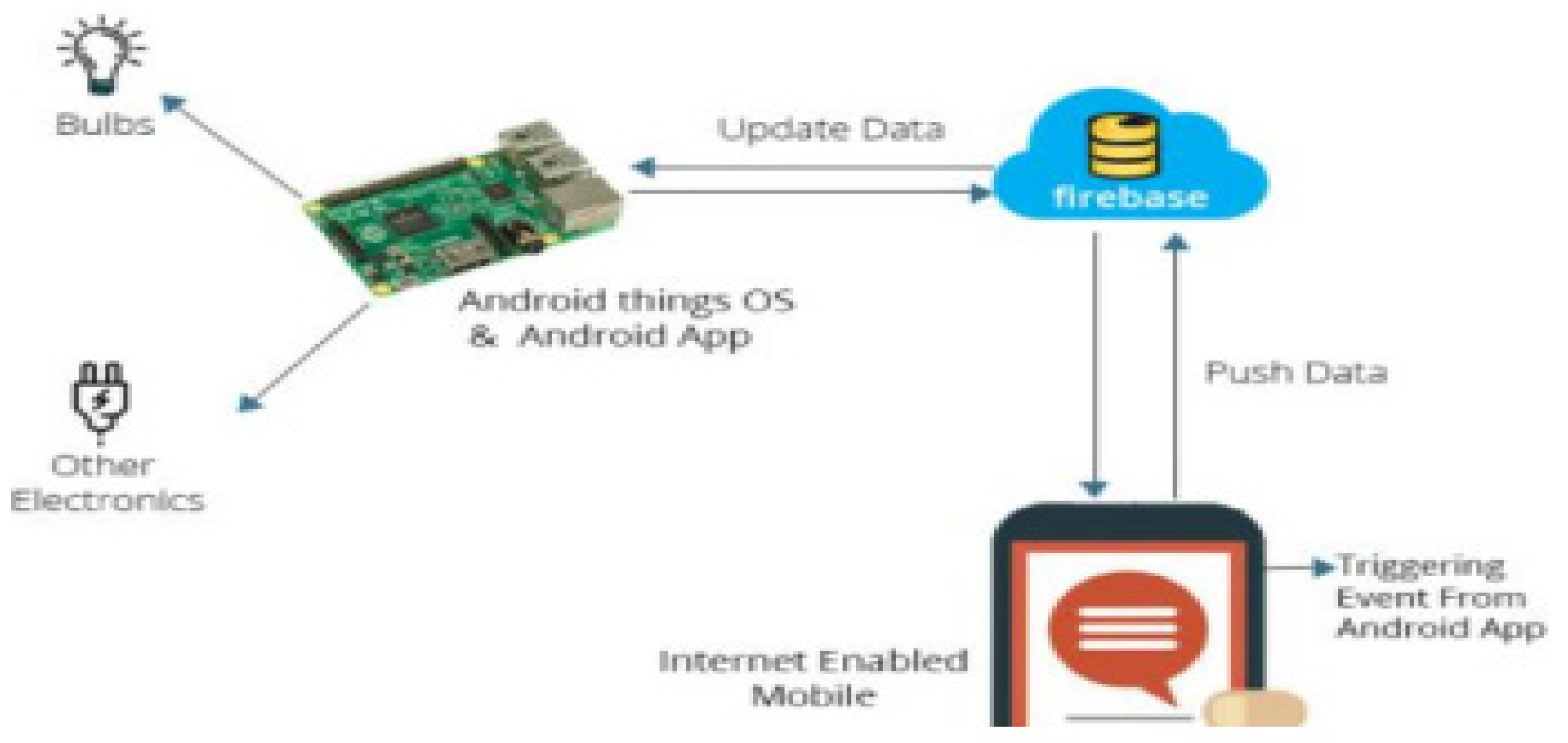The Designing of a Wireless Integrated Building Infrastructure Automation System †
Abstract
:1. Introduction
2. Literature Review
3. Methodology
3.1. System Architecture
3.2. Overall Setup
3.2.1. Node A
3.2.2. Node B
3.2.3. Node C
3.2.4. Bridge 1
3.2.5. Bridge 2
3.2.6. Central Agent (Raspberry Pi)
3.3. Mesh Network Formation
3.4. Sub-Systems
3.4.1. Electrical Power Monitoring
3.4.2. Electrical Power Protection System
- PHLPTOC: a low fault protection stage. In this case, the definite time characteristic curve is used.
- PHHPTOC: a high fault protection stage. In this case, the IDMT characteristic curve is used which calculates the time delay based on the fault current magnitude.
- PHIPTOC: a very high fault protection stage. In this case, the relay does not add any intentional time delay and clears the fault as soon as possible [8].
3.4.3. Earth Leakage Protection System
3.4.4. Smoke and Gas Detector
3.4.5. Fire Detection System
3.4.6. Temperature and Humidity Monitoring
3.4.7. Water Supply Control System
3.4.8. LUX intensity Controlling System
3.5. User Friendly GUI
4. Result
Author Contributions
Funding
Institutional Review Board Statement
Informed Consent Statement
Data Availability Statement
Conflicts of Interest
References
- Oti, A.; Kurul, E.; Cheung, F.; Tah, J. A framework for the utilization of Building Management System data in building information models for building design and operation. Autom. Constr. 2016, 72, 195–210. [Google Scholar] [CrossRef]
- Jasim, S.H. Design, Programming and Implementation of Smart Building Management System Using IoT Technology. Bachelor’s Thesis, University of Technology, Baghdad, Iraq, 2020. [Google Scholar]
- Chasta, R.; Singh, R.; Gehlot, A.; Mishra, R.G.; Choudhury, S. A smart building automation system. Int. J. Smart Home 2016, 10, 91–98. [Google Scholar] [CrossRef]
- Gokceli, S.; Tugrel, H.B.; Pisirgen, S.; Kurt, G.K.; Ors, B. A building automation system demonstration. In Proceedings of the 9th International Conference on Electrical and Electronics Engineering (ELECO), Bursa, Turkey, 26–28 November 2015; pp. 56–60. [Google Scholar]
- Tariq, W.; Khan, S.; Mustafa, A. Building Management System. Asian J. Eng. Sci. Technol. 2012, 2, 106. [Google Scholar]
- Ashfaq, M.A.M.S.M. Zigbee Communication and Its Application in Building Management System. IEEE Access 2021, 1, 132–134. [Google Scholar]
- Liu, Z.; Kim, A.K. Review of Recent Developments in Fire Detection Technologies. J. Fire Prot. Eng. 2003, 13, 129–149. [Google Scholar] [CrossRef]
- ABB. Application Manual Feeder Protection Relay REF615. Available online: https://library.e.abb.com/public/f49c47babe06a298c1257b2f0054c256/REF615_appl_756378_ENk.pdf (accessed on 29 June 2022).
- Çetin, A.E.; Dimitropoulos, K.; Gouverneur, B.; Grammalidis, N.; Günay, O.; Habiboǧlu, Y.H.; Töreyin, B.U.; Verstockt, S. Video fire detection—Review. Digit. Signal Process. 2013, 23, 1827–1843. [Google Scholar] [CrossRef]
- Alkhatib, A.A. A review on forest fire detection techniques. Int. J. Distrib. Sens. Netw. 2014, 10, 597368. [Google Scholar] [CrossRef]
- Vipin, V. Image processing-based forest fire detection. Int. J. Emerg. Technol. Adv. Eng. 2012, 2, 87–95. [Google Scholar]
- Guinard, A.; McGibney, A.; Pesch, D. A wireless sensor network design tool to support building energy management. In Proceedings of the First ACM Workshop on Embedded Sensing Systems for Energy-Efficiency in Buildings, Berkeley, CA, USA, 3 November 2009. [Google Scholar]
- Al-Hamadi, H.; Saoud, M.; Chen, R.; Cho, J.-H. Optimizing the lifetime of IoT-based star and mesh networks. IEEE Access 2020, 8, 63090–63105. [Google Scholar] [CrossRef]




| Characteristics | Proposed System | S.H.JASIM et al. [2] | Moiz Ahmed et al. [7] |
|---|---|---|---|
| Wireless | Yes | No | Yes |
| Humidity & Temperature Monitoring | Yes | Yes | Yes |
| Fire Detection & Alarm | Yes | Yes | No |
| AC Controlling | Yes | No | No |
| Motor Controlling | Yes | No | No |
| Power Monitoring | Yes | Yes | No |
| Electrical System & Earth Fault Protection | Yes | Yes | No |
| Cost Effective | Yes | No | No |
Disclaimer/Publisher’s Note: The statements, opinions and data contained in all publications are solely those of the individual author(s) and contributor(s) and not of MDPI and/or the editor(s). MDPI and/or the editor(s) disclaim responsibility for any injury to people or property resulting from any ideas, methods, instructions or products referred to in the content. |
© 2023 by the authors. Licensee MDPI, Basel, Switzerland. This article is an open access article distributed under the terms and conditions of the Creative Commons Attribution (CC BY) license (https://creativecommons.org/licenses/by/4.0/).
Share and Cite
Nadeem, N.; Sultana, U.; Khan, B.A.; Zaib, H. The Designing of a Wireless Integrated Building Infrastructure Automation System. Eng. Proc. 2023, 46, 38. https://doi.org/10.3390/engproc2023046038
Nadeem N, Sultana U, Khan BA, Zaib H. The Designing of a Wireless Integrated Building Infrastructure Automation System. Engineering Proceedings. 2023; 46(1):38. https://doi.org/10.3390/engproc2023046038
Chicago/Turabian StyleNadeem, Numair, Umbrin Sultana, Bilal Ahmed Khan, and Huzaifa Zaib. 2023. "The Designing of a Wireless Integrated Building Infrastructure Automation System" Engineering Proceedings 46, no. 1: 38. https://doi.org/10.3390/engproc2023046038
APA StyleNadeem, N., Sultana, U., Khan, B. A., & Zaib, H. (2023). The Designing of a Wireless Integrated Building Infrastructure Automation System. Engineering Proceedings, 46(1), 38. https://doi.org/10.3390/engproc2023046038





